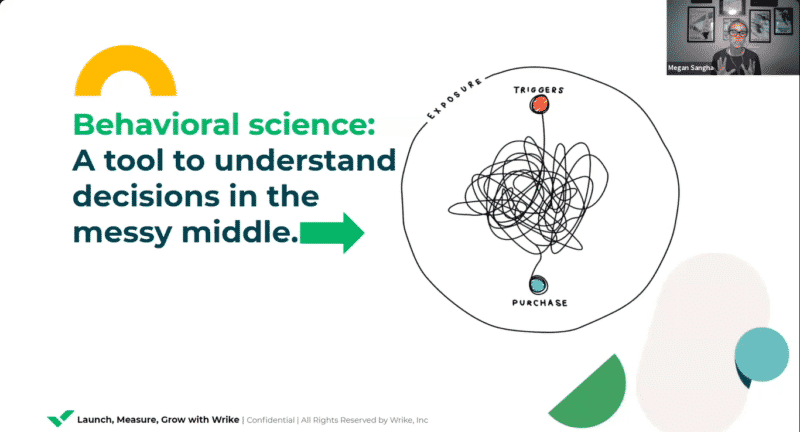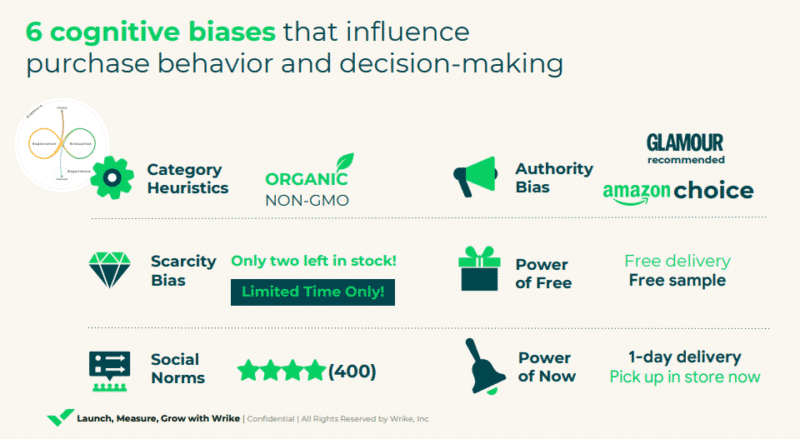How marketers can use behavioral data to improve customer experiences

Understanding customer behavior is vital to enhancing experiences.
“Marketers are expected to deliver campaigns that cultivate rich customer experience and drive brand awareness, all within a quick turnaround time,” said Megan Sangha, Senior Product Marketing Manager at Wrike, in her presentation at our MarTech conference. “Things could be different if science and data were combined within a single source of truth platform to help drive better outcomes.”
Digital disruptions are occurring more than ever before thanks to the 2020 pandemic and technological innovation. These changes have altered the way consumers behave in the purchasing process, which has in turn forced brands to accelerate their digital transformation efforts.
“With consumer behavior drastically shifting to digital, this world is crowded with competitors quickly working to capture consumer attention,” Sangha said. “Marketing executives are struggling to stand out from competitors while trying to keep their current customers. “
“Now more than ever, marketers need to be innovative and creative with their tools and data to quickly deliver eye-catching and innovative campaigns to stand out among the rest,” she added.
Despite the prevalence of tight deadlines and dwindling resources, marketers are expected to provide customers with engaging experiences. To combat this, Sangha recommends turning to psychology, gleaning behavioral insights from buyer journeys.
Use behavioral science to understand decisions
“Behavioral science is a great strategy for optimizing campaign performance through the help of psychology,” Sangha said. She pointed to a helpful diagram (shown below) that illustrates the customer decision-making process from a psychological perspective.

“The large circle is exposure or brand awareness,” she said. “Brand awareness can be found in obvious areas like the ad you see when you’re scrolling through social media or a pop up that you click on . . . Exposure is always on, always changing, and always influencing decision-making.”
Sangha then went on to describe the top and bottom points of the circle, which represent the “triggers” and “purchase” phases, respectively: “Triggers are where a consumer starts their journey. It is influenced by either exposure or a need.”
Consumers then move down into the “messy middle” of the circle, which is the phase wherein they begin exploring and evaluating brand offerings.
These exploratory and evaluation stages are where brands have the opportunity to build brand loyalty and customer satisfaction. Sangha said these are strengthened through “great customer experience, smooth transaction, and in today’s world, fast delivery.”
Understand cognitive biases that influence purchase behavior and decision-making
“Consumers are moving back and forth between exploration and evaluation, depending on the size of the purchase,” said Sangha. “For marketers, it’s not so fun. And it’s definitely not efficient. So, how can we get our customers from triggers to purchase? Through psychology.”
She added, “As people explore and evaluate within the messy middle, cognitive biases shape their shopping behavior and influence why they choose one product over the other.”

Sangha described six primary cognitive biases (shown above) that affect consumer behavior. Whether it’s consumers’ propensity to buy things perceived as scarce or those recommended by authoritative sources, it’s vital that marketers know what’s affecting their decision-making processes.
“Understanding behavioral bias and the customer journey are really important,” Sangha said. “Marketing teams that use these principles and psychology see higher customer satisfaction, lower customer turnover, improve the sales process and find better advocacy from current customers.”
Use behavioral data to optimize channel performance
“To drive better [customer] decisions, marketers need to ensure the information being provided is consumable to the masses,” said Sangha. “We don’t want stakeholders to be overwhelmed with spreadsheets and intricate dashboards that become complacent with their decision-making.”
Presenting this behavior data in a coherent fashion to other departments will help coordinate your marketing efforts companywide, leaving less room for discrepancies in customer experiences across channels. But with so many signals being tracked, it can get overwhelming quickly.
“There is so much thrown at digital marketers,” she said. “They’re using different channels, platforms, solutions, and tools to track assets, campaigns, users, customer performance data, etc. And every piece of data gives them insights on market trends and consumer behavior.”
“The only problem is that right now most digital marketers are manually piecing everything together, which means they’re spending way too much time tracking and pulling together data instead of viewing, strategizing and executing,” she added.
Sangha recommends marketers adopt a project management platform to help ensure customer data is clean and applied to the relevant channels, which can help optimize campaign performance: “A recent McKinsey study showed that digital marketers spend 80% of their time manually sifting through data, pulling together spreadsheets or dashboards to track performance data, and only 20% of their time is spent on strategy.”
She added, “Think what you could do with your campaign strategy and overall outcome if you were able to have more time to strategize versus sifting through data.”
Marketing work management: A snapshot
What it is: Marketing work management platforms help marketing leaders and their teams structure their day-to-day work to meet their goals on deadline and within budget constraints, all while managing resources and facilitating communication and collaboration. Functions may include task assignments, time tracking, budgeting, team communication and file sharing, among others.
Why it’s important today. Work environments have changed drastically due to the COVID-19 pandemic. This has heightened the need for work management tools that help marketers navigate these new workflows.
Marketers have been at work developing processes that allow them to work with those outside their own offices since marketing projects—campaigns, websites, white papers, or webinars—frequently involve working with outside sources.
Also, with marketers required to design interfaces, write content, and create engaging visual assets today, more marketers are adopting agile workflow practices, which often have features to support agile practices.
What the tools do. All of these changes have heightened the need for marketing work management software, which optimizes and documents the projects undertaken by digital marketers. They often integrate with other systems like digital asset management platforms and creative suites. But most importantly, these systems improve process clarity, transparency, and accountability, helping marketers keep work on track.
___
by Corey Patterson
source: MarTech.org

